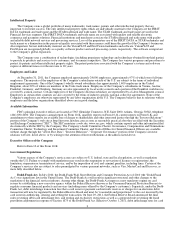First Data 2011 Annual Report Download - page 21
Download and view the complete annual report
Please find page 21 of the 2011 First Data annual report below. You can navigate through the pages in the report by either clicking on the pages listed below, or by using the keyword search tool below to find specific information within the annual report.
The ability to recruit, retain and develop qualified personnel is critical to the Company's success and growth.
All of the Company's businesses function at the intersection of rapidly changing technological, social, economic and regulatory
developments that requires a wide ranging set of expertise and intellectual capital. For the Company to successfully compete and
grow, it must retain, recruit and develop the necessary personnel who can provide the needed expertise across the entire spectrum of
its intellectual capital needs. In addition, the Company must develop its personnel to provide succession plans capable of maintaining
continuity in the midst of the inevitable unpredictability of human capital. However, the market for qualified personnel is competitive
and the Company may not succeed in recruiting additional personnel or may fail to effectively replace current personnel who depart
with qualified or effective successors. The Company's effort to retain and develop personnel may also result in significant additional
expenses, which could adversely affect the Company's profitability. The Company cannot assure that key personnel, including
executive officers, will continue to be employed or that it will be able to attract and retain qualified personnel in the future. Failure to
retain or attract key personnel could have a material adverse effect on the Company.
Failure to comply with state and federal antitrust requirements could adversely affect the Company's business.
Through the Company's merchant alliances, it holds an ownership interest in several competing merchant acquiring businesses
while serving as the electronic processor for those businesses. In order to satisfy state and federal antitrust requirements, the Company
actively maintains an antitrust compliance program. Notwithstanding the Company's compliance program, it is possible that perceived
or actual violation of state or federal antitrust requirements could give rise to regulatory enforcement investigations or actions.
Regulatory scrutiny of, or regulatory enforcement action in connection with, compliance with state and federal antitrust requirements
could have a material adverse effect on the Company's reputation and business.
The market for the Company's electronic commerce services is evolving and may not continue to develop or grow rapidly enough
for the Company to maintain and increase its profitability.
If the number of electronic commerce transactions does not continue to grow or if consumers or businesses do not continue to
adopt the Company's services, it could have a material adverse effect on the profitability of the Company's business, financial
condition and results of operations. The Company believes future growth in the electronic commerce market will be driven by the
cost, ease-of-use, and quality of products and services offered to consumers and businesses. In order to consistently increase and
maintain the Company's profitability, consumers and businesses must continue to adopt the Company's services.
The Company may experience breakdowns in its processing systems that could damage customer relations and expose it to liability.
The Company depends heavily on the reliability of its processing systems in the Company's core businesses. A system outage or
data loss could have a material adverse effect on the Company's business, financial condition and results of operations. Not only
would the Company suffer damage to its reputation in the event of a system outage or data loss, but the Company may also be liable to
third parties. Many of the Company's contractual agreements with financial institutions require the payment of penalties if the
Company's systems do not meet certain operating standards. To successfully operate the Company's business, the Company must be
able to protect its processing and other systems from interruption, including from events that may be beyond the Company's control.
Events that could cause system interruptions include, but are not limited to, fire, natural disaster, unauthorized entry, power loss,
telecommunications failure, computer viruses, terrorist acts and war. Although the Company has taken steps to protect against data
loss and system failures, there is still risk that it may lose critical data or experience system failures. The Company performs the vast
majority of disaster recovery operations itself, though it utilizes select third parties for some aspects of recovery, particularly
internationally. To the extent the Company outsources its disaster recovery, it is at risk of the vendor's unresponsiveness in the event
of breakdowns in the Company's systems. Furthermore, the Company's property and business interruption insurance may not be
adequate to compensate it for all losses or failures that may occur.
The Company may experience software defects, computer viruses and development delays, which could damage customer relations,
decrease the Company's potential profitability and expose it to liability.
The Company's products are based on sophisticated software and computing systems that often encounter development delays,
and the underlying software may contain undetected errors, viruses or defects. Defects in the Company's software products and errors
or delays in the Company's processing of electronic transactions could result in:
•additional development costs;
•diversion of technical and other resources from the Company's other development efforts;
•loss of credibility with current or potential customers;
•harm to the Company's reputation; or
•exposure to liability claims.
In addition, the Company relies on technologies supplied to it by third parties that may also contain undetected errors, viruses or
defects that could have a material adverse effect on the Company's business, financial condition and results of operations. Although
the Company attempts to limit its potential liability for warranty claims through disclaimers in the Company's software documentation
and limitation-of-liability provisions in the Company's license and customer agreements, the Company cannot assure that these
measures will be successful in limiting the Company's liability.
19
























